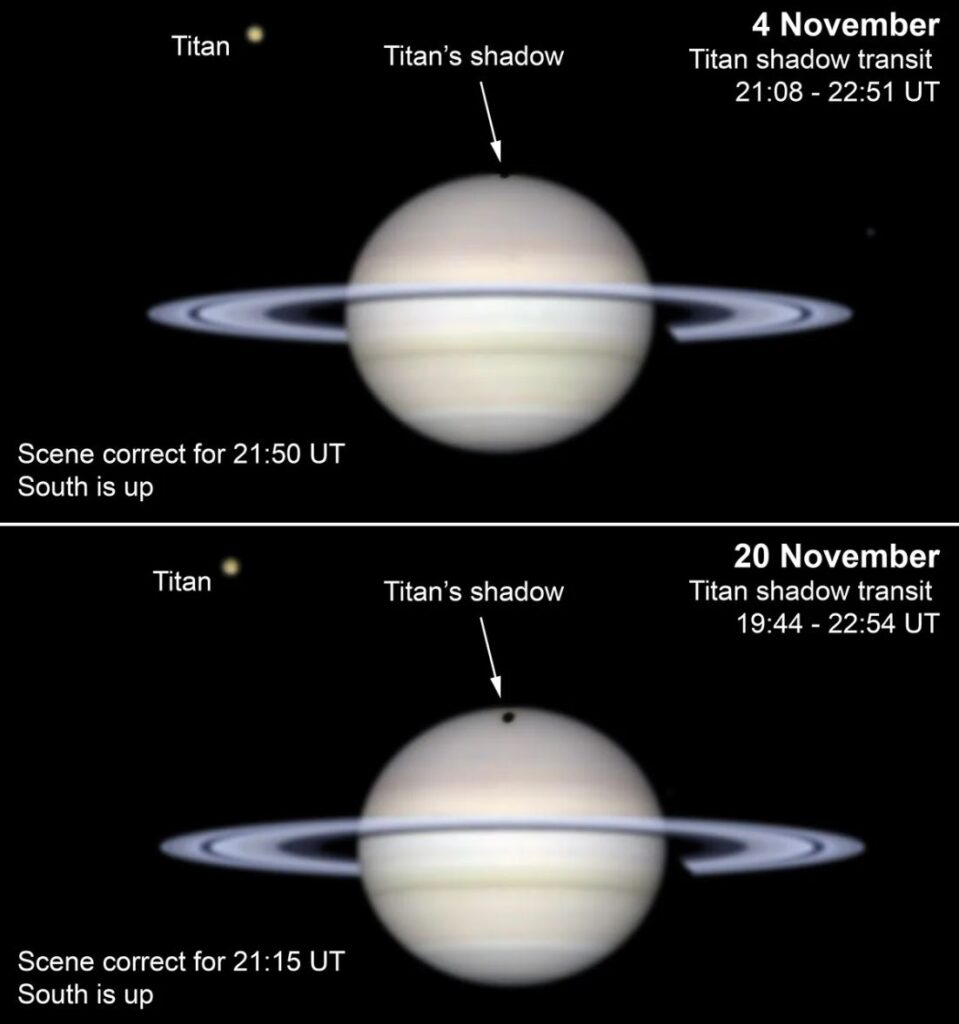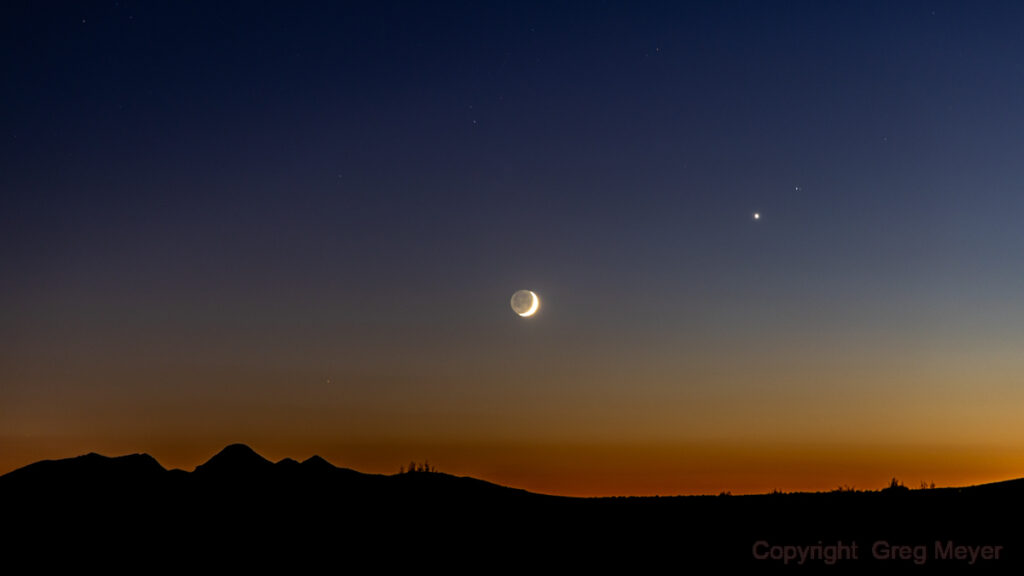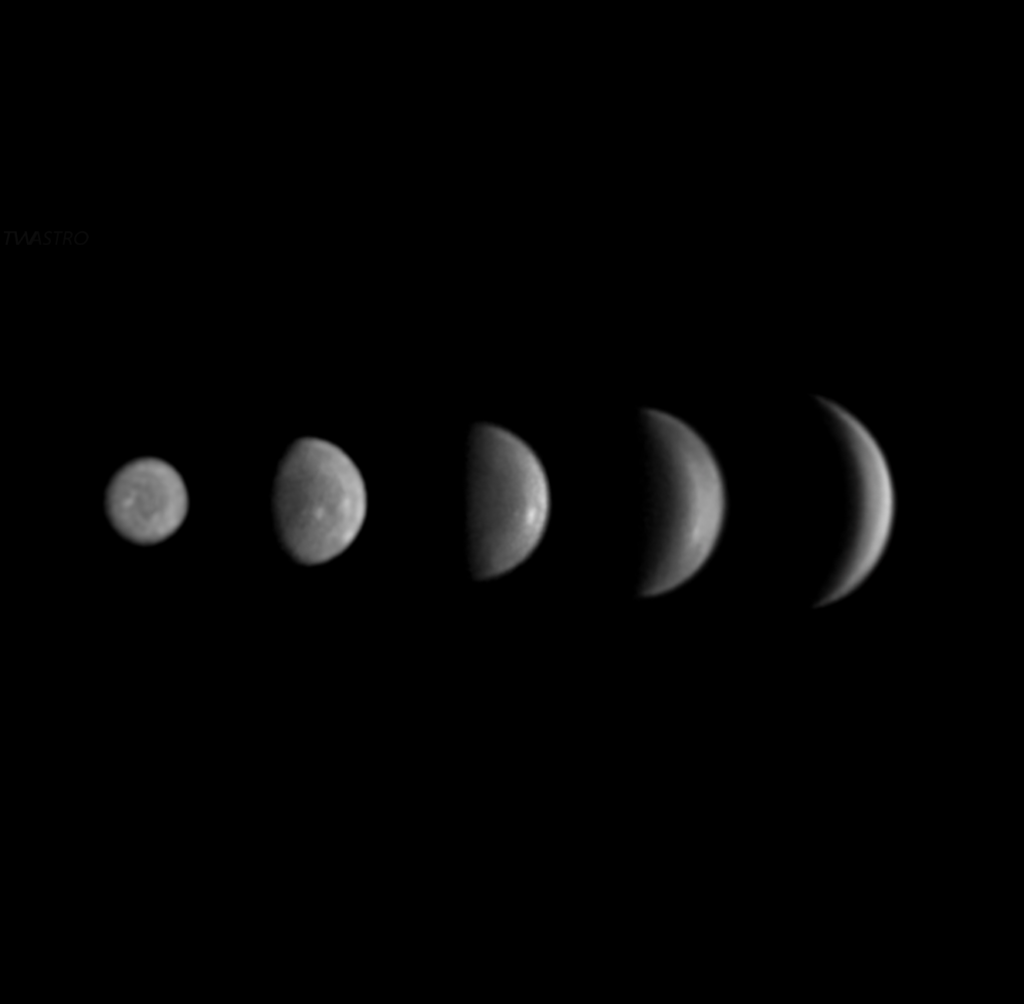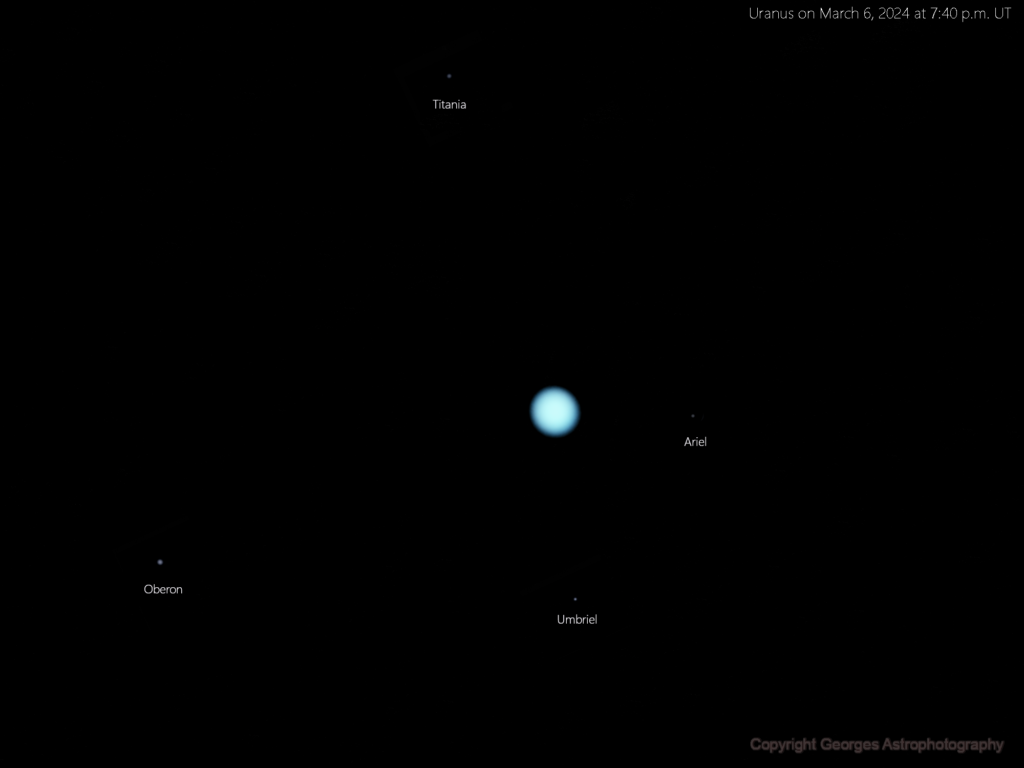The last fall month of this year will be dominated by Jupiter, as the bright planet will remain visible in the Taurus constellation during the night. Low above the western horizon, as soon as the Sun hides, the true “Queen of the Evening” – Venus, will appear, and the conditions for its visibility will continue to improve. In mid-November, the brightest planet will be joined by tiny Mercury which, at its greatest eastern elongation, will pose a real challenge for observers. This month, expect to enjoy the sight of Saturn during the first half of the night, while the second half will welcome Mars as the planet commences its journey in the Cancer constellation high in our sky.
Moreover, November 2024 marks the beginning of the season for the rare events in the Saturn system — the shadow transits of Titan, its largest moon. The conditions for the second of the month’s transits will be more favorable in Ukraine and the rest of Europe.
In early November, comet C/2023 A3 (Tsuchinshan-ATLAS) will remain visible for binoculars and small telescopes, though it will also be available for astrophotography. The comet’s brightness is decreasing at a lower rate compared to October, and is predicted to drop to approximately 9.3 magnitude, so you’ll need a fairly powerful amateur instrument to catch it.
Curiously, autumnal skies encompass stars from both summer and winter seasons. So even in November evenings, you’ll still be able to admire the Summer Triangle of Altair, Deneb, and Vega. Meanwhile, the second half of the night will be set alight by bright constellations like Auriga, Taurus, Gemini, Orion, Canis Major, and Leo.
Upcoming Events
👀 🔭 📷 November 1 — The New Moon.
👀 🔭 📷 November 4 — Titan’s shadow transit over Saturn.
👀 🔭 📷 November 5— The Moon (17%) and Venus (4.0m) conjunction will appear low in the Western sky.
👀 🔭 📷 November 11 — The Moon (71%) and Saturn (0.9m) conjunction. The exact time for the event is 02:48 UT or 04:48 EST, with the objects passing at a distance of only 0.3°, though they will still be hidden below the horizon. So it’s better to catch the meeting of the Moon and Saturn in the evening of November 10 and 11.
👀 🔭 📷 November 15 — this full moon is also the last Supermoon of 2024.
👀 🔭 📷 November 15 — The Moon (100%) and Uranus (5.6m) conjunction occurs at 23:42 UT, or November 16 at 01:42 EET, as the distance between them narrows down to 3.8°.
👀 🔭 📷 November 16 — Mercury (-0.3m) at the greatest eastern elongation (22.5°), will appear low in the south-west after sunset.
👀 🔭 📷 November 16-17 — the peak of Leonids meteor shower, a radiant in the Leo constellation. The shower is set to last throughout November between the 6th and 30th, peaking at ZHR 15. This year, the shower observations will be slightly impeded by the Moon’s 98% illumination, although the meteors are still fairly fast and bright.
👀 🔭 📷 November 17 — Uranus (5.6m) at opposition; this is the best time to watch the planet with the naked eye.
👀 🔭 📷 November 20 — Titan’s shadow transit over Saturn.
👀 🔭 📷 November 20 — The Moon (71%) and Mars (-0.3m) conjunction; occurs at 21:07 UT (23:07 EST), with the Moon passing at 2.4° South of the planet.
Overview of the Most Noteworthy Events
November 1: The New Moon — Perfect time for observing deep space objects
For those observers only beginning their skywatching journey, we definitely recommend paying close attention to the standout stellar cluster M45, also known as the Pleiades or Seven Sisters asterism, located in the Taurus constellation. Resembling a small dipper, it can even be seen with the naked eye. Though it’s possible to discern between 9 and 11 stars without any equipment, the cluster will truly shine in all its detail when viewed through binoculars or a small telescope.
A more substantial skywatching object is the open star cluster Hyades. In the ancient star charts of Taurus, the cluster is depicted circling the Bull’s head. Hyades is truly brimming with stars, a show you can see for yourself armed with a pair of binoculars. More experienced observers could also hunt for the Crab Nebula which is also located in Taurus constellation.
Star clusters NGC 869 and NGC 884 of the Perseus constellation as well as the Andromeda Galaxy (M31) appear pretty high in the sky and could even be seen with the naked eye, provided the suburban skyline is clear of light pollution. But for a more detailed look at another fairly bright galaxy of this season, the Triangulum Galaxy or M33, you will definitely need binoculars or a small telescope.

November 4 and 20: Rare transits of Titan’s shadow over Saturn
🔭 📷 – suitable for telescope observations and astrophotography with appropriate equipment.
Out of 146 currently confirmed Saturn moons, only about 4 or 5 are accessible for amateur telescope observations. Titan is the largest and brightest of the lot. Since its orbit almost coincides with the Saturn ring plane, the satellite casts a shadow upon the rings when they incline towards us almost edge-on.
At present, Saturn’s rings are gradually “closing”, which marks the beginning of the Titan’s shadow transit season over Saturn’s surface. These events tend to be quite rare, occurring in a series about every 15 years, as it’s roughly the amount of time it takes Saturn to reach the most favorable point for terrestrial observations.
The first transit of this series will occur on November 4 between 21:21 UT and 22:41 UT or 23:08 and 00:51 EST. However, this apparition won’t be that observer-friendly: Saturn’s rather low position in the sky, while Titan’s shadow will pass right along its parent’s edge.
November 20 will offer more favorable conditions for this event. For the transit’s ingress at 19:44 UT, Saturn will appear roughly 20° above the horizon (though this may vary depending on your location), and Titan’s shadow will pass directly over the planet’s globe. The transit egress will occur at 22:54 UT, but the planet will already be hidden from our view.
When planning your observations, keep in mind that even Saturn’s largest satellite still has a rather small shadow, measuring roughly 1 arc second. For this event, you’ll be best off using a 150 mm telescope or more, and bring the magnification to the maximum effective. However, you might try your luck with a smaller instrument, provided it has a long focal length. In any case, Titan’s shadow will appear as a tiny dark dot on Saturn’s surface close to its Southern limb.

November 5: The Moon-Venus conjunction
👀 📷 – suitable for visual observations and photography.
The exact moment of conjunction will occur on November 5, at 00:03 UT or 02:03 EST, with the anglular separation between the objects narrowing down to 2.5°. If for you, the Moon and Venus will be below the horizon at that moment, then the best time for observation would be on November 4 and 5 evening.
We suggest planning for November 5, since the Moon will appear higher above the horizon, almost in the same altitude as Venus. As for the suitable observation point, it’s best to keep your South-West skyline clear. The event will be observable 20 to 30 minutes after sunset. The Moon’s slight crescent and Venus’ bright shine will join to offer an incredible view against the backdrop of the vibrant evening sky, creating a perfect opportunity to take breathtaking photos.

Venus and the Moon on October 6, 2024. Photo: Greg Meyer
November 16: Mercury at the greatest eastern elongation
👀 🔭 📷 – suitable for observations with the naked eye and telescopes, as well as for photography.
The evening of November 16 will provide an opportunity to watch Mercury travel low over the South-West skyline. These conditions for this month’s greatest eastern elongation are not exactly favorable, posing a real challenge for skywatching enthusiasts. Even though the planet’s elongation will reach 22.5°, its farthest orbital point from the Sun, it will disappear below the horizon only 57 minutes after sunset. This means that you should get ready to hunt the elusive planet as soon as the Sun sets.
For the best observation experience, make sure to keep the South-West skyline clear, and find an elevated spot — the higher, the better. There is still a risk of confusing Mercury and Venus. The latter is much brighter and located higher in the South. To make sure you’re looking at the right thing, we recommend using digital planetariums.

Mercury phases in succession, captured through an amateur telescope between 2022 and 2024 when the planet reached different elongation points. Photo: Tom Williams
November 17: Uranus at opposition
👀 🔭 📷 – could be observed with or without equipment; suitable for photography with appropriate equipment.
Uranus is considered to be the farthest planet that could still be observed with the naked eye. Though it’s important to note that even at opposition with its 5.6m brightness, Uranus ekes on the limits of human visual perception, and even then the conditions have to be right, including low light pollution and clear atmosphere.
Uranus is in opposition roughly once a year. However, the planet’s apparent brightness won’t meet significant changes through the upcoming months. We will be able to observe it almost the entire night. At first, the icy giant will be visible at night, later shifting to the evenings when it passes the Taurus constellation in only 7° from the Pleiades. All in all, there will be plenty of opportunities to catch it before April 2025.

Uranus surrounded by its largest satellites. Amateur photography. Source: astrobin.com


